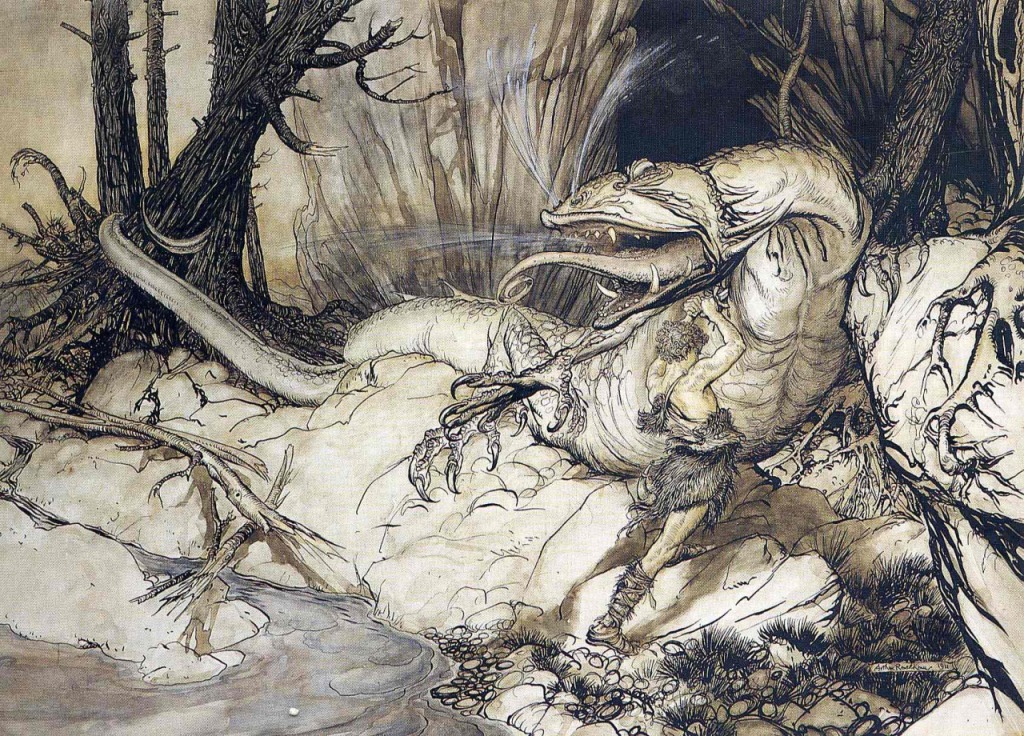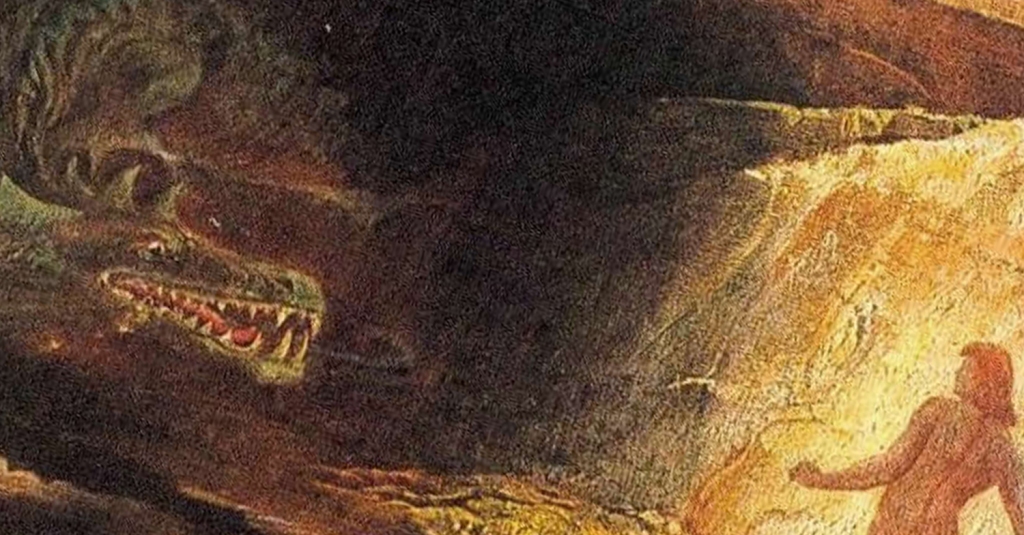Years before J.R.R. Tolkien had considered penning his “New Lays” he was writing a mythology of his own, one in which he was pulling from the same Norse sources, and hinting at the kinds of poetic traditions that led up to the composition of Sigurd and Gudrún in the early 1930s. In The Book of Lost Tales II (BLTII), Christopher Tolkien writes that there was “evidence that the Tale of Turambar was in existence at any rate by the middle of 1919,” which is more than a decade before the Lays, but clearly illustrates the tradition of the dragon slayer and cursed treasure much like Tolkien’s Lay (70-71).
In “Turambar and the Foalόkë,” Turin is the paragon dragon slayer of Glorund, who leaves the massive treasure hoard of Nargothrond unwatched after his death, save for the dwarf Mîm, who claims the treasure for his own. When Úrin and the Elves come to reclaim it, Mîm tells them, “no good can it bring Man or Elf, but I, only I, can ward it, Mîm the dwarf, and by many a dark spell have I bound it to myself” (BLTII 113-114). It is questionable whether the treasure rightly belongs to the dwarf; nevertheless, he is killed, and Mîm lays a curse upon it, saying, “because of the death of Mîm the dwarf shall death follow this gold so long as it remains on earth, and a like fate shall every part and portion share with the whole” (BLTII¸ 114).
Tolkien’s original tale of cursed treasure, just like in The Lay of Regin, has a dwarf as the chief actor for the initiator of fate in the story, and it follows the same formula for a curse where the agent performs an illocutionary act of saying the curse aloud for the audience to understand, which then produces a perlocutionary object in the warning. There is also the direct perlocutionary sequel for Úrin alone, in that after hearing the warning, “Úrin shuddered, but his folk laughed,” the result of which is Úrin being alarmed by the curse, much different than his companions (BLTII 114). The treasure itself is also the object of the curse, but the perlocutionary consequence of death for those who share in the treasure is also one that will reap its reward in the future, also as is intended for Andvari’s curse. Words have power and have to mean something when they are performed, and they have to have consequences on reality.
Later, closer to the time of writing Sigurd and Gudrún, Tolkien was revising the story of the curse in The Quenta, the greater part of which was written in 1930, but much of it remains near to the first iteration. Mîm had stumbled upon the treasure of Nargothrond and took it as his own, and this time, it is Húrin’s company that slays the dwarf, who then curses the treasure. There is no mention of their reaction to the dwarf’s curse, but it says that they were filled with lust for the treasure, so it can be assumed that, like Sigurd, they are not bothered by it. However, the curse is quick to find its mark as the perlocutionary consequences of Mîm’s illocutionary force, where it says “the curse came upon the possessors in this wise. Each one of Húrin’s company died or was slain in quarrels upon the road” (Shaping 158-159).
Although, Húrin is not the ultimate victim of the curse, and just as in “Turambar and the Foalόkë,” the treasure is thrown at the feet of Tinwelint/Thingol so that it may pass on and fulfill its objective. In neither case, though, does Úrin/Húrin relay the curse to the king, unlike in Loki or Fáfnir’s role, so that where Tolkien utilizes the curse as the prime mover in the fate of all those who carry the gold, he does not continue the theme of repetition to create suspense in this scene. Nonetheless, as Brown argues for the effectiveness of curses in epics, the curse “cannot be removed by any physical means, but must work itself out to the point of death or reconciliation” (202). This function then unleashes a series of unfortunate episodes, whether it be in Sigurd’s tale or in Tolkien’s mythology.
In The Book of Lost Tales II, the tale of “The Nauglafring,” also in The Quenta, is this series of events that culminates in the curse playing itself out. Christopher Tolkien observes that “the elements of ‘spell’ and ‘curse’ are dominant in this tale, to such degree that they might almost be said to be the chief actors in it. The curse of Mîm on the gold is felt at every turn of the narrative” (BLTII 247). This is exactly the running theme that Tolkien utilizes, thinking back on his Norse sources, when he is in the process of writing The Legend of Sigurd and Gudrún around the same time as The Quenta. Although Sigurd is the focal point of Tolkien’s Lay, everything seems to be happening around him that are contributing factors to his fate; there is not much that he does that is really of his own volition, but the curse must work itself out. It must also in the halls of Tinwelint when he is touched by its evil when he demands that the dwarves shape his gold, but the dwarves have their own plot against the elf king when they ask for the Silmaril to fashion a necklace for it.
In the Book of Lost Tales II, even with the curse upon the treasure, the dwarves are also “full of bitterness, and all its links were twined with baleful thoughts,” and when Tinwelint finally puts on the Nauglafring, “straightaway the curse of Mîm fell upon him” (BLTII 230). Just as it does in The Quenta, the lust of the Silmaril and vengeance for Mîm, leads to the dwarves killing Tinwelint/Thingol and ransacking the Thousand Caves. Indeed, the curse plays itself out to the death because of the power of the illocutionary force of saying something into being, and the perlocutionary act thereafter gives rise to the notion that this is then fate controlling the lives who are subject to the curse. Yet not only is there death, there is also reconciliation. When Beren avenges the death of Thingol and takes back the treasure and the Silmaril, “Melian warned them ever of the curse that lay upon the treasure and upon the Silmaril. The treasure they had drowned indeed in the river Ascar” (Shaping 161). This is then another instance of Tolkien borrowing from his sources concerning the cursed gold of Andvari in Norse mythology and his usage in Sigurd and Gudrún, where Gunnar says of the treasure,
“Rhine shall rule it,
rings and goblets,
in weltering water
wanly shining” (Sigurd 296).
Although the Silmarils themselves hold their own curse, the curse of Mîm, which is modeled after Andvari’s, has come to fruition, the fate of the bearers is closed, and the treasure is no longer of use to anyone.
In the literary tradition of the curse, Tolkien’s Legendarium is deeply rooted in Norse mythology. Andvari’s curse on his gold, which only occurs because Loki threw a stone, shapes the entirety of what befalls Sigurd, therefore having an effect that slithers through the plot and ultimately affects fate. This is all due to the power of words, and of the curse as being a Behabitive speech-act – where one reacts to another’s behavior or conduct – which has an illocutionary force behind it that can produce perlocutionary results. Tolkien subsequently translates this into his own mythology with the function of the curse of Mîm as the chief actor in the plot and the fate of those touched by it. Then, as Tolkien is working on his own interpretation of The Legend of Sigurd and Gudrun, this same tradition rears up once again, tying it at once to Norse mythology and his Legendarium.
Works Cited
Brown, Calvin S. “Odysseus and Polyphemus: The Name and the Curse.” Comparative Literature, vol. 18, no. 3, 1966, pp. 193–202. JSTOR, www.jstor.org/stable/1770048.
Tolkien, J.R.R. The Book of Lost Tales II, edited by Christopher Tolkien, Del Rey, 1992.
—. The Legend of Sigurd and Gudrún. edited by Christopher Tolkien, Houghton Mifflin Harcourt Publishing Company, 2009.
—. The Shaping of Middle-earth, edited by Christopher Tolkien, Del Rey, 1995.
Header Image: Turin and Mim, Peter Xavier Price, https://www.deviantart.com/peet/art/Turin-and-Mim-529348908




